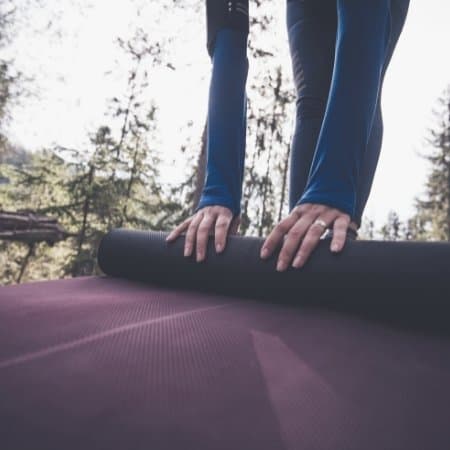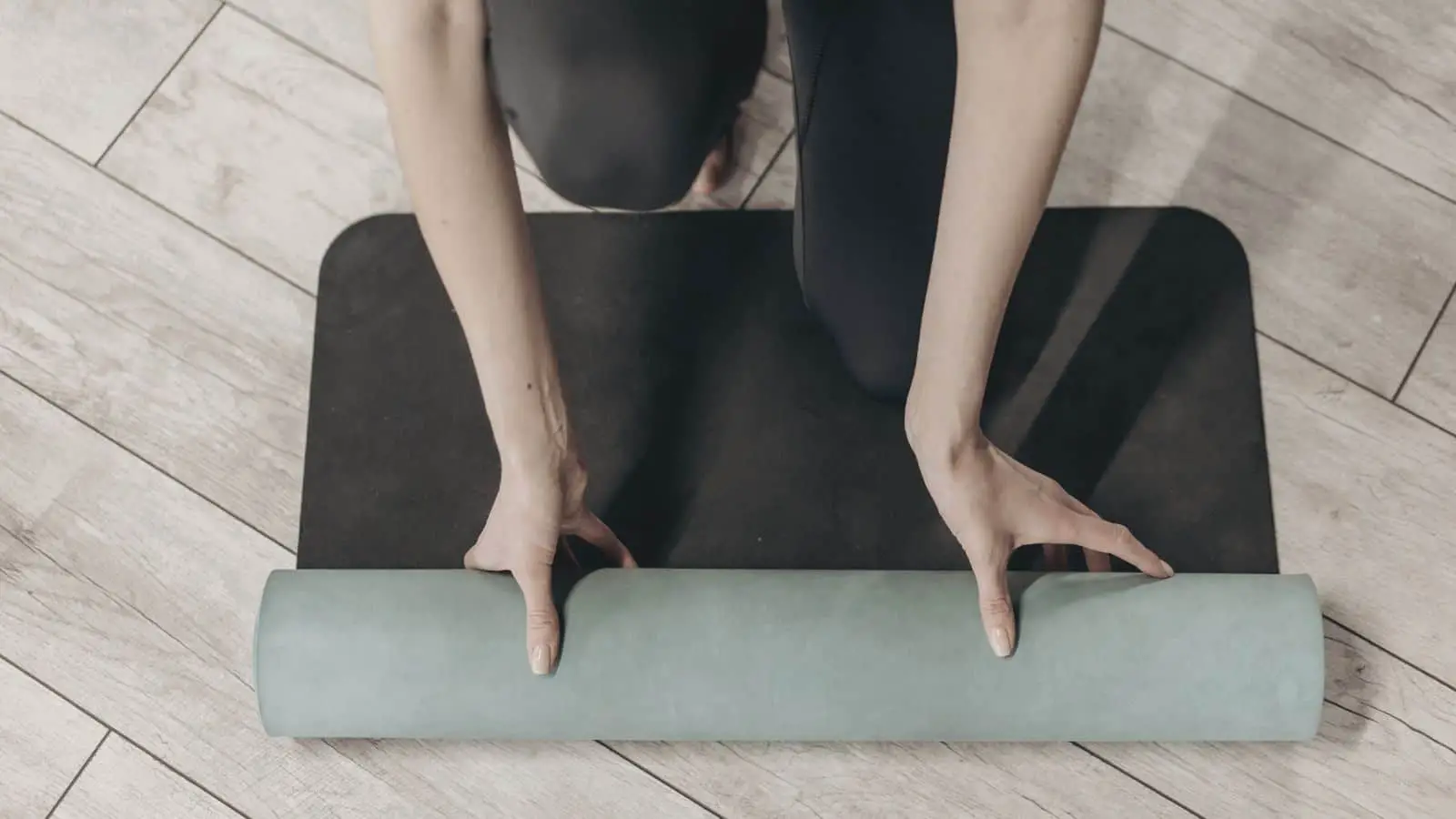If you’ve been practicing yoga for a while, you have probably reached a point that many yoga practitioners have come to dread: the flaky mat stage. Whether you notice those patchy, peeling spots right as you’re unfurling your yoga mat or only realize their presence when your face is inches from the mat in a plank pose, you’re probably wondering what exactly causes your beloved yoga mat to shed like it’s been sunburned.
Yoga mat flaking can result from several causes such as material, quality, lifespan, frequency of use, and care. Mats are more likely to start flaking sooner if they are produced of cheap materials, used often or heavily, or cleaned inappropriately or not at all. Not all yoga mats are created equal so make sure you are using a mat made to endure your fitness level and lifestyle.
Everyone practices yoga in a special way. Your yoga style, plus your values, will determine the quality and type of mat that’s best for your practice. Let’s take a more in-depth look at the factors that will help you maintain a flake-free yoga practice.
Yoga Mat Material
Yoga mats come in a variety of materials, each with its benefits and downsides. Some materials are more prone to flaking than others.

- Rubber: Mats made from natural tree rubber are considered the most eco-friendly on the market. Although they are pricier and heavier than their PVC counterparts, they hold up well to more vigorous yoga types. They may be unsuitable for people with latex allergies.
- Jute: Another eco-friendly material, jute, is a sustainable product and contains antimicrobial properties that discourage bacteria. However, those who practice intense or frequent yoga sessions may find the natural fibers begin to tear in as little as three to six months.
- Cork: This is a great choice for people who tend to sweat more or practice hot yoga because cork is very absorbent and helps prevent slipping. Although cork is reputedly durable, many comments on these mats complain of the cork being fixed haphazardly to the mat, so make sure to read those customer reviews!
- PVC: Even though PVC yoga mats are not environmentally friendly (not friendly to humans as well), marked is filled with them and sadly, they are still popular. Depending on PVC material used in making a yoga mat, these yoga mats can wear out super quickly (especially the cheap ones, filled with chemicals for the grip) OR last for hundreds of years, flaking very slowly but contributing to global plastic pollution.
Yoga Mat Quality
No matter what your yoga mat is made of, it might flake and shred prematurely if manufactured poorly or irresponsibly. Reading product reviews is one of the best ways to avoid poorly made mats.
The quality of the mat directly ties in with the material. If the material is cheap, such as the widely popular PVC/plastic yoga mats, the mat will be of poor quality. Mats that are of poor quality are not durable and are prone to flaking.
These mass-produced mats breakdown and flake, leading them to be replaced more often. Even though the initial investment is less than a higher quality mat, you’ll eventually spend more on replacements after they continue to deteriorate and flake.
Each time you replace your flaking mat, the old one is going directly into the landfill, so low-quality mats are an environmental issue as well. The best option is to choose a top-quality mat made of natural rubber.
Yoga Mat Lifespan
Some yoga mats are built to last longer than others. Yes, this is more expensive up front, but it’s well worth the price tag.
How long should you expect your yoga mat to last? Let’s say you’ve invested in an average-quality yoga mat and practice an average of three times per week. Your mat will probably last about one year before it starts showing wear and tear.
This period can shrink if you practice vigorous yoga styles like power yoga or Ashtanga. Simply being sweatier than the average person can cause your mat to wear out faster. For those who use their mats more vigorously, investing in a higher quality mat may save you money in the long run.
Liforme and Jade high-quality yoga mats are widely recommended, built from top quality natural materials meant to last. They were designed to not only enhance your practice but also outlast other mats.
How Frequently You Use Your Yoga Mat
The regularity with which you use your mat is likely the top factor for how long you can go without seeing flakes and shedding. If your yoga mat only sees action once a week in an hour-long class at the studio, a standard yoga mat should last you a year or more with proper care.
But what if you practice several times per week or every day? You’ll probably tear through cheaper mats in a matter of months. Try the Combo Mat if you’re committed to your practice. You can use this one several times a week without having to worry about replacing it every year. The added value of this mat is that it is washing machine friendly.
Cleaning and Caring for Your Yoga Mat
Yoga mats not only last longer when cared for properly, but they are also much better for your health. Rolling up your mat right after a sweaty yoga session without cleaning it is a recipe for bacteria soup. Additionally, long exposure to sweat and bacteria can cause some yoga mats to flake sooner. Cleaning and care can vary greatly depending on what your yoga mat is made of. What’s right for one mat can totally wreck another, so make sure to do your research. Here are some general guidelines for the care of different yoga mats, but make sure you check the manufacturer’s instructions before cleaning your mat.
| Yoga Mat Material | Do | Don’t |
| PVC | – Clean after each use.- Use a designated mat cleaning solution, warm soapy water, or equal parts water and vinegar.- Deep clean in the bathtub or shower once per month | – Use alcohol cleaners- Wash in a washing machine (unless instructions specify that it’s okay to do so).- Leave to dry in direct sunlight.- Try to wring out moisture like a towel. |
| Natural Tree Rubber | – Clean after each use or at least once per week.- Clean with warm, 1/20 solution of water and mild dish soap.- Clean by wiping very gently with a cloth. | – Wash in a washing machine.- Use chemical cleaners, alcohol cleaners, or essential oils.- Use a paper towel to clean.- Leave to dry in direct sunlight. |
| Jute | – Hang until completely dry.- Spot clean with water and a microfiber cloth.- Perform deeper cleanings with cold water and mild detergent.- Clean using soft motions. | – Use paper towels or mat wipes to clean.- Scrub hard as this can fray the jute fibers. |
| Cork | – Use plain cold water for regular cleanings.- For deeper cleanings, use a solution of three parts water to one part white vinegar.- Use a microfiber cloth or soft sponge.- Hang until completely dry. | – Use chemical mat cleaners or essential oils.- Scrub harshly or use abrasive cleaning tools. |
Final Thoughts
All of these factors can feel intimidating to consider at first, but keep in mind that the perfect yoga mat is within reach as long as you know your habits, commit time to care for your mat, and are willing to put in a bit of research.
When shopping for a new mat, pay attention to customer reviews by practicing the same type of yoga as you to make sure you get the perfect fit.








